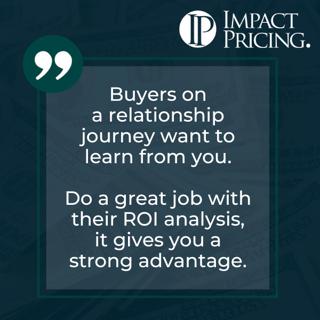
Blogcast #69: Subscribe to Heated Seats in a BMW
This is an Impact Pricing Blog published on July 20, 2022, turned into an audio podcast so you can listen on the go. Read Full Article Here: https://impactpricing.com/blog/subscribe-to-heated-seats-in-a-bmw/ If you have any feedback, definitely send it. You can reach us at mark@impactpricing.com. Now, go make an impact. Connect with Mark Stiving: Email: mark@impactpricing.com LinkedIn: https://www.linkedin.com/in/stiving/
26 Aug 20223min

Memecast #72: Ace of Spades: Stacking the Deck in Your Favor by Increasing Customer Perceived Value
This meme is the Ace of Spades from the Selling Value card deck. Selling value really is the skill of increasing customer perceived value. If you think about it, our customers don't really know how much value they're going to get from our products. And yet we as salespeople, product people, pricing people, we've seen other customers use our products. We've seen all the different places where they get value from our products. And if we've done a really nice job, we've been able to quantify some of that value that some of our previous clients have gotten. Doesn't it make sense then that in a sales situation we find a way to help this buyer, someone who's evaluating our current product, to learn about and understand all the different ways our product might be able to add value to them. And once we can do that were increasing the amount of value that customer perceives for our product. This is how we win more deals at higher prices. So, selling value really is the skill of increasing customer perceived value. We hope you enjoy this memecast. This is also an example of how Pricing Table Topics works. Grab a deck of our cards, pull out a random card and read the saying. Then talk for one to two minutes about what the card says. This will improve your understanding, and more importantly, your ability to communicate important concepts. If you have any questions or feedback, please email me mark@impactpricing.com. Now go make an impact. Connect with Mark Stiving: Email: mark@impactpricing.com LinkedIn: https://www.linkedin.com/in/stiving/
24 Aug 20222min

Price Execution, Not Price Optimization with Flintfox CEO, John Moss
John Moss is the CEO of Flintfox International, a pricing software company with world class IP in the areas of pricing and revenue management. He’s previously worked as the Chief Strategy Officer and also General Manager of MYOB. John is also trained to use explosive and radioactive devices. In this episode, John talks about the work they do at Flintfox. He explains why pricing models should change in line with the updates constantly happening at present on software. Additionally, Mark and he discuss the complexity of pricing, especially in these days of high inflation. Why you have to check out today’s podcast: Discover why pricing models in software businesses should change from time to time Understand the current situation and complexities in pricing, especially in this time of high inflation Find out how much of a game-changer it will be to have organizations focus more on pricing and not just in cost reduction “For many organizations, pricing has been off to the side and somebody who's got a quantitative bent will do that and look into it. I think there's an increasing need to employ experts in the organization that understand pricing, that understand pricing models, how you create value, and can help you manage through the current period of uncertainty.” – John Moss Topics Covered: 01:18 – How John got into pricing 02:37 – Lessons learned as they transitioned from transactional to subscription pricing 04:14 – Talking about the work Flintfox does 06:51 – What makes Flintfox different from other pricing software companies? 09:40 – Discussion about the complexity of pricing nowadays 11:20 – Avoiding channel conflict and posting things for the public to see 13:25 – The challenge of increasing prices during this period of inflation 18:02 – John, business software, and value-based pricing 22:36 – Pricing table topics: “Fixed costs never matter to pricing. Never, never, never.” 25:04 – John’s pricing advice Key Takeaways: “Software is no longer build something, release it, and it stays stable and constant forever. Software nowadays is constantly evolving and changing, and so the pricing model for that product had to change as well.” – John Moss “It's increasingly important, I think, to have a good data set and an integrated data set to be able to understand exactly how your product portfolio is performing and what margins you're making.” – John Moss “We're seeing more people have the confidence to put through a higher increase in the expectation that they do it once and maybe it lasts for 9-12 months, as opposed to putting through 3% now and then come back in two or three months’ time for another 3%, which that sort of attritional increase is probably less well received by customers than a big bang.” – John Moss “It's a consequence of software. What young people and you and I now expect is that software gets better all the time. I mean, we all see it every day. Every app we have on our phone gets updated all the time incrementally. But some of these applications do improve functionality quite significantly over a number of years. And so that's what you're paying for, effectively – the fact that the developers are still working on this product.” – John Moss People / Resources Mentioned: Flintfox International: https://www.flintfox.com/ MYOB: https://www.myob.com/ Microsoft: https://www.microsoft.com/ Connect with John Moss: LinkedIn:https://www.linkedin.com/in/johnrmoss/ Connect with Mark Stiving: LinkedIn:https://www.linkedin.com/in/stiving/ Email: mark@impactpricing.com
22 Aug 202228min

Blogcast #68: Ballet, Football, Pricing and Sales
This is an Impact Pricing Blog published on July 13, 2022, turned into an audio podcast so you can listen on the go. Read Full Article Here: https://impactpricing.com/blog/ballet-football-pricing-and-sales/ If you have any feedback, definitely send it. You can reach us at mark@impactpricing.com. Now, go make an impact. Connect with Mark Stiving: Email: mark@impactpricing.com LinkedIn: https://www.linkedin.com/in/stiving/
19 Aug 20223min

Memecast #71: Select KPIs
Possibly my single favorite KPI in the world of pricing is average selling price. Are we managing average selling price per product, average selling price overall across the portfolio. If you have a single product that has a price on it and you can monitor that average selling price, that gives you a great indication of what's going on in your marketplace, how well we're selling value. If you can monitor average selling price by salesperson, now we're getting a great indicator of which salespeople do a good job at selling value and which ones don't. If you can't manage average selling price, maybe you're going to have an average deal size. How big are the opportunities that we're facing, that we're being able to bid on? And which ones of those are we winning or not? But my recommendation, find some KPI, maybe two or three, that are a great indicator of how well our customers are perceiving our value, which means their willingness to pay and how well our salespeople are selling value. Track them over time. Watch for the anomalies. Watch for the changes. And use those as indicators to see if you can figure out what's going on in your marketplace. We hope you enjoyed this memecast. This impactful insight came from the book, Selling Value, which I wrote to help salespeople win more deals at higher prices. If you have any questions or feedback, please email me mark@impactpricing.com. Now go make an impact. Connect with Mark Stiving: Email: mark@impactpricing.com LinkedIn: https://www.linkedin.com/in/stiving/
17 Aug 20222min

How to Package Your Services and Price for Value with Gabriel Dabi-Schwebel
Gabriel Dabi-Schwebel is the Founder and CEO of SalesDeck, an online sales communication tool. He is also the Founder and CEO of 1min30, a French inbound marketing agency. He is an entrepreneur, speaker, and author of eight marketing and sales methodologies books. Gab hosts the Virtual Selling podcast. In this episode, Gabriel talks about service packaging as he shares how they do it in his marketing company, 1min30. Why you have to check out today’s podcast: Find out how to get your product packaging and pricing right Learn good, better, best service packaging through the way a marketing company does it Understand why pricing is at the heart of entrepreneurship “If you are in service, the idea of packaging what you sell is very important.” – Gabriel Dabi-Schwebel Topics Covered: 01:29 – Growing up with French fonctionnaire parents while wanting to become an entrepreneur 02:19 – How Gabriel got into pricing; Gabriel realizes how important pricing is 04:36 – Talking about service packaging in line with his marketing company, 1min30 08:34 – The difference between the three price points 09:54 – Where he got the idea of his good, better, best strategy 10:36 – Did Gab learn how to have value conversations with clients? 12:06 – Gabriel’s pricing advice 14:51 – Pricing table topics: “Be strategic. Focus on lifetime value.” Key Takeaways: “I think pricing is really at the heart of entrepreneurship, because at one time, you need to price what you do, what you sell, what you create, and it’s really a marketing aspect that is very interesting, because with pricing, you can make your revenue even bigger without working too much.” – Gabriel Dabi-Schwebel “It's really important to find the right price and to be sure that the price you choose is really the closest to what a customer is ready to pay and the ones that make you the more value and the more money in your pocket.” – Gabriel Dabi-Schwebel “Really thinking about lifetime value is really thinking about what is the price being acceptable by your customer and the value you bring him, and also the fact that you keep bringing value and keep in loyal to your product.” – Gabriel Dabi-Schwebel People / Resources Mentioned: SalesDeck: https://salesdeck.io/ 1min30: https://www.1min30.com/ Acquisition Strategy Design: https://www.amazon.co.uk/gp/product/2377740324/ref=dbs_a_def_rwt_bibl_vppi_i2 Blair Enns’ The Win Without Pitching Manifesto: https://www.winwithoutpitching.com/the-manifesto/ Connect with Gabriel Dabi-Schwebel: LinkedIn: https://www.linkedin.com/in/gabrields/ LinkedIn: https://www.linkedin.com/in/gabriel-dabi-schwebel/ Connect with Mark Stiving: LinkedIn:https://www.linkedin.com/in/stiving/ Email: mark@impactpricing.com
15 Aug 202217min

Blogcast #67: A Good Case for Cost-plus Pricing
This is an Impact Pricing Blog published on July 6, 2022, turned into an audio podcast so you can listen on the go. Read Full Article Here: https://impactpricing.com/blog/a-good-case-for-cost-plus-pricing/ If you have any feedback, definitely send it. You can reach us at mark@impactpricing.com. Now, go make an impact. Connect with Mark Stiving: Email: mark@impactpricing.com LinkedIn: https://www.linkedin.com/in/stiving/
12 Aug 20223min

Memecast #70: Start with Your Goal
Pricing decisions can always help us achieve our goals. We need to make sure we understand what those goals are. I would start with understanding what the corporate objectives are. Oftentimes those are things like we need to raise our average selling price. We need to gain more market share. We need to have more margin. Typically, these goals, these corporate goals, are established by our CEO and our executive team, and they're there to drive increased market capitalization. However, your product may have a different set of goals than what your corporate goal is. So, what is the goal of your product? The goal of your product may be to bring more people into the platform so that we then have more people we can sell upgrades to. That's a great goal. We need to understand that as we're setting our pricing. Your goal may be we need to generate more revenue, more profit, so that we can fund other projects. That's a great goal. We just need to know what our goals are. As we're making these pricing decisions. We hope you enjoyed this memecast. This impactful insight came from the book, Selling Value, which I wrote to help salespeople win more deals at higher prices. If you have any questions or feedback, please email me mark@impactpricing.com. Now go make an impact. Connect with Mark Stiving: Email: mark@impactpricing.com LinkedIn: https://www.linkedin.com/in/stiving/
10 Aug 20221min






















